A vision of eternity
by Mika Provata-Carlone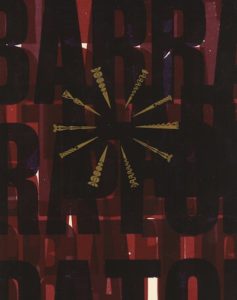
Inferno Canto XXII: The Barrators, from The Typographic Dante at the National Poetry Library © Barrie Tullett
There are infinitely more than fifteen ways of looking at Dante – we can see him as a historical figure, a radical maverick, the conscience of a Church and a State in dire crisis. He is the writer of poetry that many have come to see as the ultimate representation of the sublime, as well as the author of political treatises that aimed to exert very deliberate influence over the fate of Dante’s country and times. He can even be seen as a Byronic anti-hero, a transgressive Manfred avant la lettre who, like his guide Virgil, is almost impossible to pin down, to singularly define, docilely label and categorise.
Dante is the quintessence of polyphony – in the medieval sense of a concord of voices seeking to give expression to the polymorphy and polyvalence of the divine, as well as in the more modern sense of a discourse that is constantly fluid, in the making, self-doubting and self-questioning, for all its indomitable certainty of being written sub specie aeternitatis.
His is perhaps the first emergence of the modern ‘I’ on a popular scale, as a perspective that is both valid and vital, that can claim legitimacy and space in an age determined by theocracy, still under the rule of two-dimensional aesthetics and poetics. One might say that the Divina Commedia is an archetypal first example of the psychological novel, a breach with almost everything that had come before it. Like the introduction of optics and perspective in painting, Dante’s poetics unsettled in the most fundamental way the geography of our psyche – revealing wondrous new continents and exposing our own, very personal relationship with both eternity and the abyss of our existence.
The Commedia is both traditional and anarchical, doctrinal and irreverent. It is a text in keeping with a sacred tradition of parables, metaphors, allegories and symbols; yet it also marks a radical shift and change.”
The Divine Comedy is inextricably founded on contradiction. On the mortal tension between divine meaning and human enactment; on the polarity between eternity and individuality; on the seeming opposition between love and justice. As a rereading of Augustine’s theology, it is the ultimate tug of war between the city of god and its love of transcendence, and the city of man, and its covetousness of secular power and an ego-based value system. It is especially a poem exposing the split between high and low, rich and poor, cultured and ignorant. Like the gothic churches whose phantasmagorias of sculptural images were intended as a tactile ‘text’ for the eyes of the illiterate who could not read words but could instinctively, atavistically almost, decipher images, the Commedia is both traditional and anarchical, doctrinal and irreverent. It is a text in keeping with a sacred tradition of parables, metaphors, allegories and symbols; yet it also marks a radical shift and change: rather than writing it in the high Latin of his De Monarchia, Dante, “descends so he may ascend”, in a reversal of the Augustine paradigm that is perhaps the most extraordinary gesture of allegiance and homage. He wrote the Commedia in the Italian vernacular, the everyday language of the people – a language whose cultural status would be reflected starkly and mordantly in the term vulgata, the name for the vernacular translation of the Old Latin Bible into the common tongue of the vulgus – the unsophisticated, uneducated populace. As Plato did before him, in his myth of Er and his parable of the Cave, Dante seeks to reveal the real world behind the delusions and errors of our mortality. He is dead set to do so in the simplest, most direct and poignant manner available to him at the time.
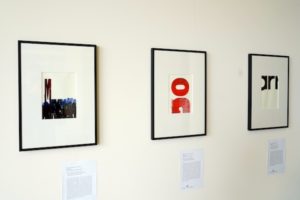
The Typographic Dante by Barrie Tullett at the National Poetry Library © Takis Zontiros/Southbank Centre
The Inferno is perhaps the book most read of the three that comprise the Commedia. Highly flamboyant, dramatic, pictorial, irresistibly tangible and terrifying, it is a dense conundrum of classical allusion and historical synchronicity. In many ways, it reads like a heavily coded penny-dreadful, a daily newspaper of the times hot off the press, stuffed full of events, editorials and personal columns. Many have seen it as a faithful endorsement and dutiful reinforcement of Catholic doctrine: sin, and this is the place that awaits you. What is perhaps more striking to some readers of this first part of Dante’s journey, however, is its concreteness, the architectural compulsiveness of its physical space, the screaming (often literally) realism of its dramatis personae. The key words for such readers are the ones inscribed above the Gates of Hell – Per me si va… Primo a me… Through me… Before me… Hell is the space of the self-absorbed, self-serving, self-starving and self-blinded ego, and Dante spares no punches in denouncing it as a very secular, terribly human construct. The Purgatorio is an exercise in redefinition: true humanity is in the I and Thou relationship with God and with our fellow men, incomparably embodied by Dante’s two guiding figures, Virgil, for the first two parts, and Beatrice in Paradiso. Purgatory, the reconstructive breakdown of the soul, is an uphill road, the ultimate, supreme exercise of human free will, which, as Socrates pointed out, can only have one option because of all its freedom – the choice of the good. Even more than the Inferno or Purgatorio, Paradiso is Dante’s true poetic masterpiece, what John Freccero has so very evocatively called the “poetry of human insufficiency” pitted against the theory of man as the measure of all things. For Dante, it was the effort to represent the unrepresentable, and language alone, its beauty and its resonance, its hold on both the mind and the soul, is the only thing that can suffice.
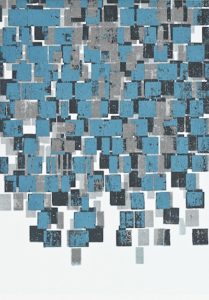
Inferno Canto XXIXI: The Valley of Disease, from The Typographic Dante at the National Poetry Library © Barrie Tullett
The Commedia is very nearly 900 years old. And yet it has never ceased to grip us, mortify us, mystify us, inspire us and still us. It has generated innumerable more words of both poetry and fiction, and especially images, as we have tried to engage with its wisdom, power and vital intimacy. From Botticelli’s haunting, disappearing lines, to Blake’s bold, masculine watercolours, Doré’s almost alchemical, dark illustrations, Rodin’s monuments to a writhing, desperate humanity, to the work of so many others, from Dante Gabriel Rossetti’s more immanent depictions, to Delacroix’s variations on the theme of castaways, to Dalí’s muscular hallucinations of genius, more recently to Michael Mazur and Tom Phillips, we can literally not take Dante out of our mind – or our eyes off his words, works, the figments of his soul. Byron wrote in his diary of the Italians, “Why, they talk Dante, write Dante, and think and dream Dante at this moment, to an excess which would be ridiculous, but that he deserves it” (entry for 29 January 1821). We too seem to be in a constant process of Danteggiare, of seeking the path out of the woods, into the starlit openness that is the way to the stars.
Barrie Tullett has certainly been Danteggiaring for a long time – 30 years. An extraordinarily sensitive, cogent, daring and thrillingly inventive artist, he has made Dante’s journey his very own through a highly meticulous, profoundly reflected process of rereading, looking anew, distilling. Above all celebrating the organic echoes and signs that he sees as being atemporal, perpetual, and ever-transforming in Dante’s poem. Tullett is an artist, artisan, teacher and master craftsman in love with letterpress printing. With the materiality and aesthetics of the written word, with the relationship between the visual impact of texts and their meaning. He looks back to old illuminated manuscripts for the way they blur the boundaries between image and word, and to the power of the printed text to both stand up for and against. Russian formalism, Vorticism, the work (and life) of Hendrik Werkman, the avant garde of the 1920s and 1930s are strong influences behind his work, as is the art of Tom Phillips, whom he evokes again and again, and of artists such as those he showcases in his book Typewriter Art: a Modern Anthology. Judith Chernaik’s Poems on the Underground series is another reference, together with art teachers old and new with whom he feels constantly in dialogue and communion.
A highly meticulous, profoundly reflected process of rereading, looking anew, distilling. Above all celebrating the organic echoes and signs that Tullett sees as being atemporal, perpetual, and ever-transforming.”
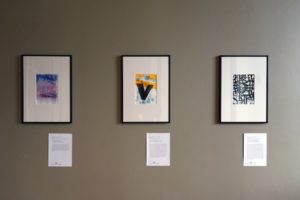
The Typographic Dante by Barrie Tullett at the National Poetry Library © Takis Zontiros/Southbank Centre
The vital tension between old and new informs his practice, which is determinedly manual, un-digital, a long, painstaking process in an old garage at home with a particular focus on detail, the perfection of the line, the balance between the elements, in the service of a higher metaphor of meaning. Also the perceived contradiction between the ineluctable passage of time and patience, between the split-second assessment and a more meditative, invested understanding. His Typographical Dante is a true labour of love, a magnum opus and a work of art of truly moving humility and brilliance. It is also a spectacular homage to the art of printing, the art that made Dante’s Commedia possible, in so many closely intertwined ways. The 34 cantos of the Inferno are realised through letterpress printing; the 33 cantos of Purgatory are brought to life through the manipulation, redefinition, reinvention of the typewriter, no longer a static machine and transcriber of texts, but a surprisingly versatile artist’s tool; the 33 cantos of Paradise use Letraset – volatile, obsolete, cumbersome, irreplaceable in its power to articulate the ineffable.
Tullett’s images are audaciously muscular and ethereal at the same time. They are suffused with conviction and doubt, with a very striking sense of vision and transcendence that is grounded on a deep espousal of the human condition. He uses scaling and warping of proportions to create a sense of depth and perspective and to counter flatness, resulting in works that evince a very personal visualisation of abstraction. Every plate shows a breathtaking degree of urgency and engagement – captioned with the lines that inspired it, it will leave you speechless, transfixed by the perfection of what is in so many ways an imagistic statement.
His Inferno is as wild, bold and materially visual as Dante’s original. There is an almost anatomical sense of distillation of the absolutely essential here, and it is unfailingly powerful, staggering to see each canto reduced and magnified at the same time to its ‘modicum’, that inexpressible ‘little while’ that defines blindness and true vision in John 16:16 and in Dante’s Paradiso. Many of the plates are realised through a superimposition of the graphic elements, others through a process of constant writing and erasure, like true palimpsests of human existence.
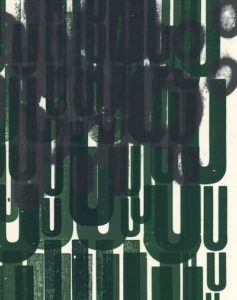
Inferno Canto XXIV: Consumed and Restored, from The Typographic Dante at the National Poetry Library © Barrie Tullett
Purgatorio is the rite of passage from chaos to order, from total loss to a recovered enunciation and being. Tullett’s typewriter paradigm is strikingly evocative, poignant, unmistakable, an act of both renunciation and resistance against the virtual volatility of our digital textual existence. The interplay between custom and reinvention, the challenge of overcoming the discipline and rigidity of the machine in order to redefine its purpose and its future, produces startling results, both monumental in their geometricity and unseizable in their aesthetics and poetry.
Paradiso (still a work in progress) for Tullett is an exercise in perfect symmetry, in perfection itself, and if the process has been demanding, it has certainly proven an extraordinarily fruitful one, an almost sublime example of minimalism and abstraction. Its main motif is the circularity and dance-like quality of the celestial spheres, the eternal rosa mystica formed by the souls of the blessed, the impossible vision that Dante is allowed to be part of. Mortal and Orpheus-like, Dante intended the Paradiso to be pure form, idea, poetry and music. Tullett’s plates capture the link between fragility and glory, between the present moment and eternity.
Tullett says that his Dante is especially the man that emerges from his relationship with Virgil. The interaction and bond between mentor and pupil are vital to him as an artist, as a teacher, as a private individual, and during our conversation the voices that are the echoes in his mind, the people who have guided and inspired him were constant references, conjuring up an almost blessed community of spiritual and artistic companions. Engrossed by the art of the printed text in its purest, most dynamic form, he chose to focus on letterpress art rather than conventional pictorial illustration from the start. The text, its corpus of words, is in itself the material for giving visual body to a narrative. From a board game that was the predecessor to Dungeons & Dragons and Marvel Comics, to Dorothy Sayers’ Lord Peter Wimsey who led him to her translation of Dante, and Margery Allingham’s Albert Campion, Wimsey’s parodic alter ego, Doré, Dalì and Mucha, especially through Tom Phillips and Michael Mazur, Tullett has sought his own pictorial vernacular – learning inspiration, as he says, in a non-specific way. He has sought and has created polyphony, polysemy, a uniquely rich and fecund visual and semantic discourse and interchange with a text that is admittedly a daunting one to tackle – a real sacred monster.
For Tullett Dante’s text is a way of teaching and of learning. An act of breaking down language, visual expectation, narrative complexity in order to enhance their most vital qualities and forces.”
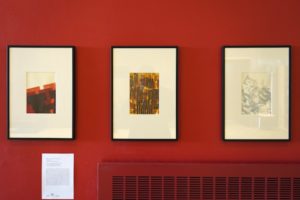
The Typographic Dante by Barrie Tullett at the National Poetry Library © Takis Zontiros/Southbank Centre
It feels as though for Tullett Dante’s text is a way of teaching and of learning. An act of breaking down language, visual expectation, narrative complexity in order to enhance their most vital qualities and forces. He is drawn by the potential afforded by the exploration of the poem’s engagement with presence and disappearance, and he defines his own relationship with Dante and his poem, with the act of trying to illustrate the Commedia, as being fraught with ‘impostor syndrome’: “have I really got the right to be working with this material in this tradition?” Tullett’s Typographical Dante is a resounding answer that, if anything, he evinces the best credentials and qualities for the task. His own pilgrim’s progress, using ink and paper in such an original and yet organically tradition-infused manner, provides a truly new way of looking at the text, a vibrant, crucial way of approaching the Commedia and all it could mean for us now, as it did then. He says that part of the enchantment was revisiting the narrative, revising his own ideas, even incorporating mistakes, and the thrill he has experienced throughout the process is palpable as he speaks. It is a thrill that will not fail to capture the hearts and minds of those who have a chance to see this exhibition, a journey in itself through the spaces of the National Poetry Library and the Members’ Room of the Royal Festival Hall. It was an unforgettable privilege to have the chance to talk to Barrie Tullett on the opening day of the show, and to listen to his tale and artistic vision about each of the typographical cantos on the walls.
Barrie Tullett is a freelance graphic designer and senior lecturer and programme leader at Lincoln School of Art & Design. He grew up in Walthamstow, East London and studied at St Martin’s School of Art and Chelsea School of Art. He is the author of Typewriter Art: A Modern Anthology (Laurence King, 2014) and along with Philippa Wood he is part of a collective called The Caseroom Press. The Typographic Dante continues at the National Poetry Library to 30 June.
More info
barrieagogo.co.uk
@southbankcentre
Mika Provata-Carlone is an independent scholar, translator, editor and illustrator, and a contributing editor to Bookanista. She has a doctorate from Princeton University and lives and works in London.

